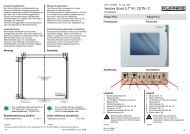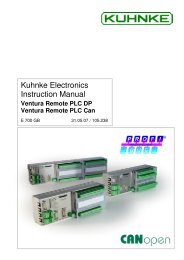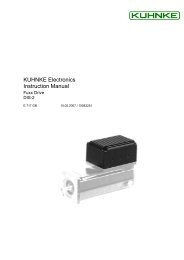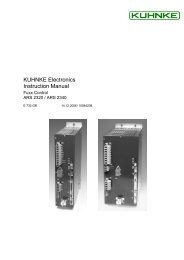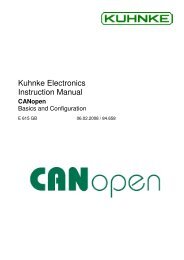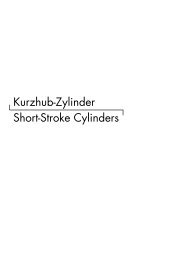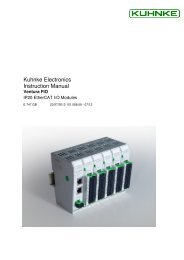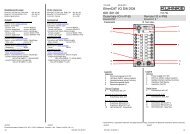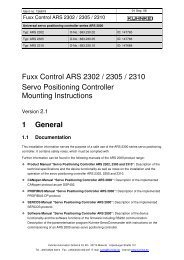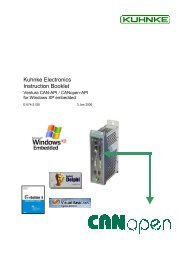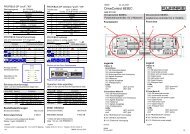KUHNKE Instruction Manual
KUHNKE Instruction Manual
KUHNKE Instruction Manual
You also want an ePaper? Increase the reach of your titles
YUMPU automatically turns print PDFs into web optimized ePapers that Google loves.
<strong>KUHNKE</strong><br />
<strong>Instruction</strong> <strong>Manual</strong><br />
AS-Interface – Introduction and<br />
Basic Information<br />
E 704 GB 18.05.2006 / 107.069
This instruction manual is primarily intended for use by design, project and development engineers. It does not contain any availability<br />
information. Data is only given to describe the product and must not be regarded as guaranteed properties in the legal sense. Any<br />
claims for damages - on whatever legal grounds - are excluded except for instances of deliberate intent or gross negligence on our<br />
part.<br />
We reserve the rights for errors, omissions and modifications.<br />
Reproduction even of extracts only with the editor's express and written prior consent.<br />
Microsoft ® , Windows ® and the Windows ® logo are registered trademarks belonging to the Microsoft Corp. in the USA and other<br />
countries.
Table of Contents<br />
AS-Interface<br />
1 Introduction......................................................................................................................................................5<br />
1.1 AS-Interface in automation ..................................................................................................................5<br />
1.2 Cost-effectiveness, ease of assembly and maintenance ....................................................................5<br />
1.3 The AS-Interface on the periphery of networks ...................................................................................5<br />
1.4 Levels of Automation ...........................................................................................................................6<br />
2 Reliability, Safety .............................................................................................................................................7<br />
2.1 Intended Use........................................................................................................................................7<br />
2.2 Target Group........................................................................................................................................7<br />
2.3 Reliability..............................................................................................................................................7<br />
2.4 Symbols ...............................................................................................................................................7<br />
2.4.1 Danger................................................................................................................................................7<br />
2.4.2 Attention .............................................................................................................................................8<br />
2.4.3 Note....................................................................................................................................................8<br />
2.4.4 Under Construction ............................................................................................................................8<br />
2.4.5 <strong>Instruction</strong>...........................................................................................................................................8<br />
2.5 Safety ...................................................................................................................................................8<br />
3 AS-Interface.....................................................................................................................................................9<br />
3.1 Introduction ..........................................................................................................................................9<br />
3.2 The main components .........................................................................................................................9<br />
3.3 Piercing technology............................................................................................................................10<br />
3.4 Network topology ...............................................................................................................................10<br />
3.5 Runs safely and reliably.....................................................................................................................11<br />
3.6 Economics..........................................................................................................................................12<br />
3.7 Standardisation ..................................................................................................................................12<br />
3.8 Certification ........................................................................................................................................13<br />
3.9 AS-Interface characteristics ...............................................................................................................13<br />
3.10 Master-Slave communication .........................................................................................................13<br />
3.11 Extended with system ....................................................................................................................14<br />
3.12 AS-i Safety at Work ........................................................................................................................15<br />
3.12.1 Function: System safety.................................................................................................................15<br />
3.12.2 Safety at Work in use .....................................................................................................................15<br />
3.12.3 Safety relevant components...........................................................................................................16<br />
4 Application .....................................................................................................................................................17<br />
5 Start Up..........................................................................................................................................................18<br />
5.1 Checklist for beginners and experienced users.................................................................................18<br />
5.2 Mounting Hints ...................................................................................................................................19<br />
5.2.1 General Assembly tricks ..................................................................................................................19<br />
5.2.2 Ten valuable mounting hints ............................................................................................................19<br />
6 AS-I master....................................................................................................................................................22<br />
6.1 Ventura AS-I.......................................................................................................................................22<br />
6.1.1 Ventura, the PC-based, variable-performance control platform ......................................................22<br />
6.1.2 System Description ..........................................................................................................................22<br />
6.1.3 Software ...........................................................................................................................................23<br />
6.1.4 Technical Data .................................................................................................................................24<br />
6.1.5 Technical Data Ventura USV ...........................................................................................................24<br />
6.1.6 Technical Data Ventura Touch.........................................................................................................24<br />
6.2 Other masters ....................................................................................................................................24<br />
7 AS-I slaves ....................................................................................................................................................25<br />
7.1 AirBox 1/32.........................................................................................................................................25<br />
E 704 GB 3<br />
18.05.20066
Introduction and Basic Information<br />
7.1.1 Overview AirBox 1............................................................................................................................25<br />
7.1.2 Overview AirBox 32..........................................................................................................................26<br />
7.1.3 Application........................................................................................................................................26<br />
7.1.4 Installation / Wiring...........................................................................................................................27<br />
7.1.5 Putting into Service ..........................................................................................................................27<br />
7.1.6 Logical Assignment AirBox 1 ...........................................................................................................27<br />
7.1.7 Logical Assignment AirBox 32 .........................................................................................................28<br />
7.1.8 Notes ................................................................................................................................................28<br />
7.1.9 Dimensions.......................................................................................................................................28<br />
7.1.10 Technical Data (as per AS-I specification).....................................................................................29<br />
7.2 AirBox K .............................................................................................................................................30<br />
7.2.1 Overview ..........................................................................................................................................30<br />
7.2.2 Application........................................................................................................................................30<br />
7.2.3 Installation / Wiring...........................................................................................................................31<br />
7.2.4 Connector.........................................................................................................................................31<br />
7.2.5 Putting into Service ..........................................................................................................................31<br />
7.2.6 Logical assignments (PLC output bit to function of the pneumatic module)...................................32<br />
7.2.7 Status LEDs and their operating states ...........................................................................................32<br />
7.2.8 Notes ................................................................................................................................................32<br />
7.2.9 Functional Principle (with double acting cylinders) ..........................................................................33<br />
7.2.10 Dimensions.....................................................................................................................................33<br />
7.2.11 Technical Data (as per AS-I specification).....................................................................................34<br />
7.3 Other AS-I slave modules ..................................................................................................................35<br />
7.3.1 Concept ............................................................................................................................................35<br />
7.3.2 Active and Passive Modules ............................................................................................................35<br />
8 Further AS-i system components ..................................................................................................................36<br />
8.1 AS-i cable...........................................................................................................................................36<br />
8.2 AS-Interface Power supply ................................................................................................................37<br />
8.3 AS-Interface repeater / extender........................................................................................................37<br />
8.3.1 Area of application ...........................................................................................................................37<br />
8.3.2 Using the repeater............................................................................................................................37<br />
8.3.3 Using the extender ...........................................................................................................................38<br />
8.4 Addressing unit ..................................................................................................................................38<br />
8.4.1 Area of application ...........................................................................................................................38<br />
8.4.2 Handling ...........................................................................................................................................38<br />
9 Appendix........................................................................................................................................................39<br />
9.1 Order Data .........................................................................................................................................39<br />
9.1.1 Order Data Ventura ASi ...................................................................................................................39<br />
9.1.2 Order Data Ventura Accessories .....................................................................................................39<br />
9.1.3 Order Data Ventura Touch...............................................................................................................40<br />
9.1.4 Order data AirBox 1 .........................................................................................................................41<br />
9.1.5 Order data AirBox 32 .......................................................................................................................42<br />
9.1.6 Order data AirBox K .........................................................................................................................43<br />
9.2 FAQ....................................................................................................................................................45<br />
9.3 References.........................................................................................................................................45<br />
9.4 Sales & Service..................................................................................................................................45<br />
9.4.1 Main Factory in Malente...................................................................................................................45<br />
9.5 Index ..................................................................................................................................................46<br />
4 E 704 GB<br />
18.05.2006
1 Introduction<br />
1.1 AS-Interface in automation<br />
AS-Interface<br />
Industry has placed many demands on modern automation systems,<br />
requiring also that the necessary functions be offered at a good<br />
price/performance ratio. The AS-Interface system meets this requirement not<br />
only through its modular expandability.<br />
The objective in its creation was not a universal field bus for all areas of<br />
automation, but rather an economically reasonable system for the lower field<br />
level. The AS-Interface was developed in order to network binary sensors<br />
and actuators to the higher control level. Important development objectives<br />
included simple and cost-effective assembly with low wiring costs.<br />
1.2 Cost-effectiveness, ease of assembly and maintenance<br />
The interface is an enduring part of the modern industrial landscape. Many<br />
sensors and actuators can be networked through the 2-wire cable, which<br />
also supplies the power. By eliminating the cable trees of traditional cabling<br />
and replacing them with the yellow AS-Interface cable, significant cost<br />
reductions through simple wiring without a lot of training are the result.<br />
Thanks to its simple, defined electromechanical interface the AS-Interface<br />
can be installed without the need for any special expertise. The "Snap and<br />
Go" cable penetration system has proven itself. The freely selectable<br />
network topology and ease of configuration make installation that much<br />
easier. Ease of assembly requiring little prior knowledge reduces downtime<br />
when faults occur.<br />
The fault susceptibility of other systems often results in assembly delays, so<br />
the AS-Interface was consciously designed to reduce error sources. The<br />
special profile of the AS-Interface cable prevents reversal of the poles when<br />
connecting devices, and is just one example of the measures taken to<br />
reduce error frequency. Installation, a large cost factor, is drastically reduced<br />
by using the system. The low installation costs show the AS-Interface to be a<br />
technically and economically realistic solution to the normal fieldbus.<br />
1.3 The AS-Interface on the periphery of networks<br />
The AS-Interface, which is more an intelligent form of cabling than a true<br />
fieldbus, neither can nor intends to replace complex networks. But on the<br />
lower level of industrial communication, the Sensor/Actuator Level, the<br />
system stands out with its simple and cost-effective solutions. Modern<br />
studies even verify the economical advantage to integrating the AS-Interface<br />
with switches and buttons on control panels. The low added cost of the AS-<br />
Interface Slave Chip are made up for by the reduced wiring expense. For<br />
quite some time already there have been gateways, links or other bus<br />
couplers for all the usual fieldbus systems (e.g. CAN, DeviceNet, Ethernet,<br />
Interbus, Profibus and others). The high capability for integrating into other<br />
networks makes the modular construction of automation networks just that<br />
much easier. Cost-effective, rugged AS-Interface components are especially<br />
suited for use in harsh industrial environments.<br />
E 704 GB 5<br />
18.05.20066
Introduction and Basic Information<br />
1.4 Levels of Automation<br />
6 E 704 GB<br />
18.05.2006
2 Reliability, Safety<br />
2.1 Intended Use<br />
2.2 Target Group<br />
2.3 Reliability<br />
2.4 Symbols<br />
2.4.1 Danger<br />
AS-Interface<br />
<strong>KUHNKE</strong> products are designed as resources for use in industrial<br />
environments.<br />
All other applications need to be discussed with the factory first. The<br />
manufacturer shall neither be liable for any other than the intended use of<br />
our products nor for any ensuing damages. The risk shall be borne by the<br />
operator alone. The use as intended includes that you read and apply all<br />
information and instructions contained in this manual.<br />
This instruction manual contains all information necessary for the use of the<br />
described product (control device, control terminal, software, etc.) according<br />
to instructions. It is written for design, project planning, servicing and<br />
commissioning experts. For proper understanding and error-free application<br />
of technical descriptions, instructions for use and particularly of notes of<br />
danger and warning, extensive knowledge of automation technology is<br />
compulsory.<br />
Reliability of <strong>KUHNKE</strong> products is brought to the highest possible standards<br />
by extensive and cost-effective means in their design and manufacture.<br />
These include:<br />
• selecting high-quality components,<br />
• quality agreements with our suppliers,<br />
• actions to avoid static charges when handling MOS circuits,<br />
• worst case planning and design of all circuits,<br />
• visual inspections at various stages of fabrication,<br />
• computer-aided tests of all assemblies and their interaction in the circuit,<br />
• statistical assessment of the quality of fabrication and of all returned<br />
goods for the immediate taking of appropriate corrective actions.<br />
Despite the measures described the occurrence of faults or errors in<br />
electronic control units - even if most highly improbable - must be taken into<br />
consideration.<br />
Please pay particular attention to the additional notices which we have<br />
marked by symbols throughout this instruction manual. While some of these<br />
notices make you aware of possible dangers, others are intended as a<br />
means of orientation. They are described further down below in descending<br />
order of importance.<br />
This symbol warns you of dangers which may cause death or grievous bodily<br />
harm if operators fail to implement the precautions described.<br />
E 704 GB 7<br />
18.05.20066
Introduction and Basic Information<br />
2.4.2 Attention<br />
2.4.3 Note<br />
2.4.4 Under Construction<br />
2.4.5 <strong>Instruction</strong><br />
2.5 Safety<br />
This symbol draws your attention to information you must take a look at to<br />
avoid malfunctions, possible material damage or dangerous states.<br />
This symbol draws your attention to additional information concerning the<br />
use of the described product. This may include cross references to<br />
information found elsewhere (e.g. in other manuals).<br />
This symbol tells you that the function described was not or not fully<br />
available at the time this document went to press.<br />
Wherever you see these symbols in the left margin, you will find a list of<br />
steps instructing you to take the appropriate computer or hardware actions.<br />
They are intended as a means of orientation wherever working steps and<br />
background information alternate (e.g. in tutorials).<br />
Our products normally become part of larger systems or installations. The<br />
information below is intended to help you integrate the product into its<br />
environment without dangers to humans or material/equipment.<br />
To achieve a high degree of conceptual safety in planning and installing an<br />
electronic controller, it is essential to exactly follow the instructions given in<br />
the manual because wrong handling could lead to rendering measures<br />
against dangers ineffective or to creating additional dangers.<br />
8 E 704 GB<br />
18.05.2006
3 AS-Interface<br />
3.1 Introduction<br />
3.2 The main components<br />
AS-Interface<br />
The AS-Interface solution is more an intelligent wiring system than a real<br />
fieldbus. Simple sensors and actuators can be connected over a two leader<br />
bus, including the power supply, at very low costs. In the traditional wiring,<br />
every single signalling transmitter and -recipient is wired directly with the<br />
superior control. Rampant cable trees and voluminous control cubicles were<br />
the consequence. With the AS-Interface system, the cables and primarily the<br />
assembly cost are reduced. By the open structure of the system, it is no<br />
competition but the technical and economic addition for the primary<br />
fieldbuses. With the large product line of many companies, the AS-Interface<br />
offers solutions for the integration of most different sensors and actuators<br />
into almost all automation networks.<br />
The equipment listed in the graphic cannot illustrate the complete product<br />
line. Many products are offered by several manufacturers. Therefore visit the<br />
online product catalogue to obtain a detailed summary of the available<br />
variety.<br />
E 704 GB 9<br />
18.05.20066
Introduction and Basic Information<br />
3.3 Piercing technology<br />
3.4 Network topology<br />
The simple connection technique of the AS-Interface system is ensured by<br />
the defined, electromechanical interface with piercing technology.<br />
• mechanically coded flat cable<br />
• two wires for data and power<br />
• insulation piercing connectors<br />
• simple and safe<br />
• protection class up to IP67, even after disconnecting<br />
• directly connected slaves<br />
• sensors, actuators<br />
• valve terminals<br />
• electrical modules etc.<br />
Line Star<br />
Tree<br />
10 E 704 GB<br />
18.05.2006
3.5 Runs safely and reliably<br />
AS-Interface<br />
The protocol of the AS-Interface system ensures a simple extendibility. The<br />
AS-Interface network can be configured like any conventional electrical<br />
installation. Every AS-Interface Slave is freely addressable and can be<br />
connected to the bus cable in any arbitrary place. This makes a modular<br />
construction possible, and due to the robust operating principle, there are no<br />
limits to the structure and any network topology can be used: e.g. bus, star,<br />
or tree topologies.<br />
Reliable transmission of data:<br />
• Each telegram will be checked by the receiver for possible faults. This<br />
will be done by checking the parity bit and several other independent<br />
values.<br />
• By these means an extremely high reliability is achieved in detection of<br />
single and multiple faults.<br />
• The repetition of a single telegram only consumes 150 µs and is already<br />
taken into account in the specified cycle time.<br />
• If the mounting hints are observed, the AS-Interface can easily be used<br />
even in an environment with high electro-magnetic noise, like welding<br />
machines and frequency converters.<br />
E 704 GB 11<br />
18.05.20066
Introduction and Basic Information<br />
3.6 Economics<br />
3.7 Standardisation<br />
Hardware<br />
• I/O cards in PLC, PC<br />
• size of cabinets<br />
• PG-fittings<br />
• multiple connectors<br />
• cable ducts, bridges<br />
• tracks of slip rings<br />
• terminal housings<br />
• distributing clamps<br />
• cable / wiring<br />
Expenditure<br />
• less installation time<br />
• less test time<br />
• less time to create wiring diagrams<br />
• less expenditure of labelling cables and clamps<br />
Standardisation of the AS-Interface system in IEC 62026-2 is a further<br />
example of the success of the system. However, a norm does not suffice to<br />
ensure the full and easy integrability of all certificated AS-Interface products.<br />
All AS-Interface products correspond to<br />
• Euro Norm EN 50295 and<br />
• World Standard IEC 62026-2<br />
12 E 704 GB<br />
18.05.2006
3.8 Certification<br />
Master call A-Slaves<br />
Slave reply A-Slaves<br />
Master call B-Slaves<br />
Slave reply B-Slaves<br />
AS-Interface<br />
The certified products of the AS-Interface system ensure the customer of the<br />
highest possible degree of system security. The products are fully<br />
compatibly and interchangeable. The simplicity of the system and the<br />
interoperability only can be achieved by the AS-Interface certificate.<br />
A product to rely on<br />
3.9 AS-Interface characteristics<br />
3.10 Master-Slave communication<br />
The specifications of the AS Interface are complete and their compliance is<br />
monitored by the Certification Board. Users recognise tested and certified<br />
products by the AS-Interface shadow logo, combined with the corresponding<br />
test number.<br />
AS-i specification 2.0<br />
• Master Slave system<br />
• Free choice of network structure<br />
• 2 wire cable for data and power up to 8A<br />
• Safe transmission<br />
• Unshielded cable 2 x 1,5 mm²<br />
• 4 Inputs and 4 Outputs on each slave, in case of more than 31 Slaves<br />
only 3 outputs<br />
• In field use (IP 65/67) as well as in the control cabinet<br />
• Piercing technology<br />
• Cable range 100 m, scaleable by repeater up to 300m<br />
• Effective error detection and immunity<br />
• Simple installation<br />
• Electronic slave addressing<br />
E 704 GB 13<br />
18.05.20066
Introduction and Basic Information<br />
3.11 Extended with system<br />
AS-i specification 2.1<br />
Belonging to the AS-Interface specification 2.1 the extended addressing<br />
mode allowed operating up to 62 Slaves at one master. With a complete<br />
expansion of the system the cycle time has increased up to 10 ms. Using the<br />
extended addressing mode you have to accept restrictions in parameterise<br />
and in the number of available outputs.<br />
The addressable rage from 1 to 31 further lasts, however.<br />
• 62 Slaves at one Master / A- and B-Slaves<br />
• Keeping the full downwards compatibility<br />
• Existing application can be extended with new modules<br />
• Existing slaves can communicate with new masters<br />
• Detailed diagnostics<br />
• Separated evaluation of configuration and slave errors<br />
• Short circuit, overload<br />
• Missing additional power<br />
• Communication error<br />
• Simple error analysis and easy to maintain<br />
• Analogue value transmission simple and fast<br />
• Analogue value (16 bit value) is directly available in the plc<br />
software<br />
• Automatic detection of analogue slaves<br />
• No configuration software necessary<br />
14 E 704 GB<br />
18.05.2006
3.12 AS-i Safety at Work<br />
3.12.1 Function: System safety<br />
SPS<br />
IPC<br />
Gateway<br />
to higher<br />
Bus systems<br />
(e.g.<br />
ProfiBus)<br />
AS-i<br />
Master<br />
AS-i<br />
Netzteil<br />
Safety<br />
Slave<br />
Safety<br />
Monitor<br />
3.12.2 Safety at Work in use<br />
Slave<br />
Slave<br />
Repeater<br />
AS-i<br />
Power<br />
supply<br />
Slave<br />
Slave<br />
AS-Interface<br />
• The available AS-Interface components (Master, Slave, Power supply<br />
units) are replaced with a safety monitor and safe slaves and they are<br />
operated on the same AS-Interface power system.<br />
• Safety slaves are integrated into the system in the same way that<br />
conventional slaves are.<br />
• The required safety level is reached by additional signal transmissions<br />
between slaves and safety monitor.<br />
• If an expected message does not reach a safety slave or if it sends an<br />
emergency message, the safety monitor disconnects the safety outputs<br />
the within 35 ms (the overall response time).<br />
• The equipment is safely turned off and an alarm message is sent to the<br />
master.<br />
E 704 GB 15<br />
18.05.20066<br />
Safety<br />
Slave<br />
Standard AS-i Sensoren und<br />
sicherheitsgerichtete Sensoren<br />
Standard AS-i Aktuatoren und<br />
sicherheitsgerichteter Monitor<br />
• Applications as far as category 4 are practicable in accordance with EN-<br />
954-1<br />
• Use the standard AS-i communications protocol<br />
• Overall response time 45 ms<br />
• TÜV and BIA have inspected the safety concept<br />
• Safety AS-i products comply with the AS-Interface standard EN 50295<br />
• Available systems are extendable with the safety components<br />
• Capable of parameterisation<br />
• Diagnosable, the trigger of the emergency stop signal is accurately<br />
located.<br />
• Reduction of the downtime<br />
• Considerable reduction in costs compared to conventional wiring
Introduction and Basic Information<br />
3.12.3 Safety relevant components<br />
AS-Interface Safety at Work installs components like e.g.<br />
• Emergency stop switch<br />
• Light barrier<br />
• Guard door contact<br />
• Safety light grid<br />
safely and directly into the AS-Interface system.<br />
The non-stop function safety of all sensors and actuators and the reliable<br />
feedback have top priority to protect the co-workers and the equipment.<br />
16 E 704 GB<br />
18.05.2006
4 Application<br />
AS-Interface<br />
Wherever AS-Interface is being adopted – and with the simple connectivity<br />
and robustness of the system this means in more and more applications<br />
worldwide - you will find AirBox as the ideal controller of pneumatic actuators<br />
in most industries:<br />
• Conveyor Systems<br />
• Baggage Handling<br />
• Automotive Production<br />
• Food Industry<br />
• Process Industries<br />
• Packaging<br />
• Engine building industry<br />
Conveyor Systems<br />
Mainly stops, lifters and diverters. AirBox is ideal for mounting close to these<br />
actuators. No special enclosure or protection is required.<br />
Baggage Handling<br />
As in conveyor systems, AirBox will operate quicker than conventional valve<br />
islands. The simplicity of service replacement is a major factor. The small<br />
footprint AirBox operates surprisingly large pneumatic devices.<br />
Automotive Production<br />
AirBox is operating under arduous conditions in manufacturing cells<br />
throughout the UK. Underbody chassis welding robotics is one example, 24<br />
hour component assembly with integrated testing is another.<br />
Food Industry<br />
AirBox design, and stainless fitting options with the IP67 standard makes the<br />
AirBox suitable for clean areas and wash down. Applications include food<br />
production, food canning and packaging and dairies.<br />
Process Industries<br />
The AirBox is widely used as a pilot device for switching larger pneumatically<br />
operated flow valves. The AirBox will operate in outdoor conditions without a<br />
problem. Applications frequently involve the rapid operation of rotary<br />
cylinders.<br />
Packaging<br />
The high operating speed of the AirBox makes this a perfect product,<br />
particularly where pre-build and on site re-commissioning procedures are<br />
used. Complex lines such as tea bag production use the versatile features of<br />
auxiliary air for failsafe restart after e-stop.<br />
E 704 GB 17<br />
18.05.20066
Introduction and Basic Information<br />
5 Start Up<br />
5.1 Checklist for beginners and experienced users<br />
How many inputs and outputs are required?<br />
The number of inputs and outputs tells you how many AS-Interface networks<br />
you need.<br />
How much power do the I/Os require?<br />
The total power requirement of the respective modules determines which<br />
AS-Interface power supply unit you need. As it is not possible to connect<br />
power supply units in parallel, a power supply unit sized to the requirement<br />
must be used.<br />
Are special cables required?<br />
Any combination of profiled and round cables is possible. External conditions<br />
determine whether rubber, TPE or PUR cables should be used. Repeaters<br />
or extenders have to be used for cable lengths exceeding 100 m.<br />
Have the addresses been correctly assigned?<br />
A plan should definitely be drawn up making it clear which addresses have<br />
been assigned to which slaves. Double addressing will not be identified as<br />
an error by the master!<br />
Which modules belong to which addresses?<br />
The modules, or rather, the slaves which are addressed, should be carefully<br />
labelled.<br />
When are the modules mounted?<br />
Only when paragraphs 4 and 5 have been dealt with. Cables can be routed<br />
in any way.<br />
How is it all configured?<br />
The configuration is simply read in by entering the AS Interface profile for<br />
each slave in the master. This usually happens automatically, but can be<br />
done manually in the controller software.<br />
Are the slaves detected?<br />
First you must check whether the master has recognised all its slaves. Only<br />
then can you switch to protected operation and switch the controller to RUN.<br />
How is testing done?<br />
Input/output tests are performed by the familiar PLC method, i.e. the sensors<br />
are activated locally and then checked in the PLC.<br />
18 E 704 GB<br />
18.05.2006
5.2 Mounting Hints<br />
5.2.1 General Assembly tricks<br />
5.2.2 Ten valuable mounting hints<br />
How do you get it up and running?<br />
AS-Interface<br />
You can either create your own controller software in the usual way, or use<br />
existing software. In the latter case, you might have to adapt the symbolic<br />
assignment of addresses.<br />
• Place power supply next to slaves with high power consumption<br />
• Twist the single cores to a two core cable<br />
• Do not install AS-Interface together with power line in the same multi<br />
core cable<br />
• Keep maximum distance between AS-Interface cable and power<br />
cable (min 15 cm).<br />
• Keep strictly maximum distance to noise sources, for instance to<br />
frequency converters<br />
• Keep maximum distance between the PLC and power devices<br />
• Do not overload the AS-Interface cable. A slave needs minimum<br />
26.5 V<br />
Tip 1 - Power supply unit<br />
On no account must AS Interface be earthed or grounded! Never use a<br />
normal power supply unit, only AS Interface power supply units (PELV) with<br />
integrated data decoupling and connect ground (GND) with system ground.<br />
Tip 2 - Network extension<br />
Without repeaters or extenders the AS Interface cable must be no longer<br />
than 100 m, including all feeders to the assembly terminals! If you want to<br />
expand the network, please note the following:<br />
Expansion with extenders:<br />
• The maximum cable length between the extender and the master must<br />
not exceed 100 m<br />
• Do not connect any slaves or AS Interface network power supply unit<br />
between the master and the extender<br />
• Never confuse the + and - lines<br />
Expansion with repeaters:<br />
• Up to two repeaters can be connected in series. This increases the<br />
cable length to maximum 300 m (i.e. 3 segments with maximum 100 m).<br />
• An AS Interface power supply unit must be connected at every repeater.<br />
• Under normal conditions, an extender must not be connected beyond a<br />
repeater.<br />
E 704 GB 19<br />
18.05.20066
Introduction and Basic Information<br />
Tip 3 - Slaves<br />
Each slave address is to be used only one. Only use addresses 1 to 31 or<br />
1A to 31B in A/ B technology (Specification 2.1). Please note: modules<br />
containing the chip SAP 4.0 can be re-addressed up to 15 times, thereafter<br />
they will retain the last address.<br />
Tip 4 - Additional auxiliary power<br />
The following applies if slaves are to be supplied with additional auxiliary<br />
power:<br />
• at 24 V DC, a PELV power supply unit should be used and, if possible,<br />
the black profiled auxiliary power cable.<br />
• at 230 V AC, if possible, the red profiled auxiliary power cable should be<br />
used.<br />
Tip 5 - Routing of the cable<br />
When laying the AS Interface cables, please note the following:<br />
• Always use the yellow profiled AS Interface cable where possible, brown<br />
for + and blue for -.<br />
• Even though communication along the AS Interface cable offers a high<br />
degree of EMC immunity, it should still be routed away from power<br />
cables, even in the control cabinet!<br />
• Every AS Interface line requires its own cable. AS Interface cables must<br />
not be laid together with others in a bus cable.<br />
• If individual cores are used (e.g. in the control cabinet), always lay<br />
parallel core pairs. In standard stranded wires, lay individual cores<br />
together or twist them.<br />
Tip 6 - Ensuring EMC immunity<br />
Connect all inductance, e.g. contactor and relay coils, valves, brakes, with<br />
suppresser diodes, variators or RC elements. If frequency inverters are<br />
used, always use network filters, output filters and shielded motor cables.<br />
Tip 7 - Sensor and actuator power<br />
Sensors and actuators must be supplied directly from the associated input or<br />
output of the slave. The cables should be kept as short as possible and<br />
away from energy cables, i.e. the slave modules should be as close as<br />
possible to the sensors and actuators. Use appropriate sensors only (e.g.<br />
with plastic housings) in case of ESD hazard.<br />
Tip 8 - Installing frequency converters<br />
• Always follow the assembly guidelines in the operating instructions.<br />
• Connect the cable shield, e.g. between filter and frequency converter<br />
and between the frequency converter and the motor, directly at both<br />
ends with a sufficient cross section (at least 4 mm²).<br />
Tip 9 - Expanding system 2.1<br />
Operating A/ B- Slaves and “new” analogue slaves is only possible with a<br />
master according to specification 2.1.<br />
20 E 704 GB<br />
18.05.2006
AS-Interface<br />
Tip 10 - Status/Diagnosis<br />
For quick error location, the status and diagnosis bits should be evaluated in<br />
the PLC.<br />
E 704 GB 21<br />
18.05.20066
Introduction and Basic Information<br />
6 AS-I master<br />
6.1 Ventura AS-I<br />
6.1.1 Ventura, the PC-based, variable-performance control platform<br />
6.1.2 System Description<br />
• Scalable processor capacity<br />
• No rotating storage hardware<br />
• No fan<br />
• 24 V power supply<br />
• Expansion slot<br />
• Interfaces: 2 x USB, 2 x Ethernet,<br />
2 x COM, CANopen, AS-Interface<br />
• 2 CF card drives or hard disk<br />
• DVI display adapter port<br />
• Fast booting<br />
• Operating systems:<br />
Microsoft® Windows® CE .NET or<br />
Microsoft® Windows® XP embedded<br />
Ventura and Ventura touch<br />
The Ventura control platform is scalable in both price and performance. Its<br />
modular design and standard on-board interfaces support flexible control<br />
solutions providing for future developments in automation. Key<br />
characteristics are the unit's passive cooling, fanless operation and CF cards<br />
used as mass storage media.<br />
The mechanical and electrical design of the Ventura control platform<br />
ensures reliable control and actuation of machines under tough everyday<br />
conditions of the industry and warrants that all data is safe even in the event<br />
of power failures. It is shock-proof and vibration-proof, features low-voltage<br />
protection and EMC compliance plus compatibility with temperatures up to<br />
50 °C. Its scalability is specifically underlined by the integration of ETX<br />
modules up to Pentium M-class processors – units with 100, 266, 733 and<br />
1000 MHz clocks are currently available. They are the logic core of add-on<br />
22 E 704 GB<br />
18.05.2006
6.1.3 Software<br />
AS-Interface<br />
peripherals such as a plug-type hardware PLC, various I/O modules and<br />
other tailored modules. Standard ports to CANopen, DVI, Ethernet, COM<br />
and USB let Ventura satisfy all communication needs. Two compact flash<br />
drives allow application and machine data to be separated from the<br />
operating system. The Ventura platform installs or mounts either in a<br />
switching cabinet or immediately behind Ventura touch.<br />
Ventura touch, the new control and display monitor, features a high-quality<br />
and long-life TFT display available in sizes 6.5’’, 10.4’’, 12.1’’ and 15’’. At the<br />
front it has IP65 protection.<br />
Operators can rest on the support of CoDeSys, the control and programming<br />
system with real-time functionality in compliance with standard IEC 61131-3<br />
plus CoDeSys SP, the cross-platform PLC runtime system in conjunction<br />
with the operating systems Microsoft ® Windows ® CE and Microsoft ®<br />
Windows ® XP embedded.<br />
CoDeSys is one of the most powerful IEC 61131-3 controller programming<br />
tools available for Windows ® environments. All five programming languages<br />
of the standard are supported. CoDeSys generates native machine code for<br />
all commercially available processors. Moreover, CoDeSys combines the<br />
capabilities of high-level programming languages such as C or Pascal with<br />
the simple handling and the functionality of a PLC programming system.<br />
Apart from the programming system, the package also contains a manual<br />
and an online help engine. Operators can choose from German, English and<br />
French versions.<br />
Programming interfaces<br />
Ethernet, CAN, RS232<br />
Other benefits<br />
• Comprehensive offline simulation<br />
• Integrated visualisation<br />
• Integrated bus configurators for CANopen, PROFIBUS and AS-interface<br />
• Integrated motion functions<br />
CoDeSys components<br />
Editors allow the programming of instruction lists, sequential function charts,<br />
function diagrams, Structured Text, ladder diagrams, and function diagrams<br />
in free graphics mode.<br />
E 704 GB 23<br />
18.05.20066
Introduction and Basic Information<br />
6.1.4 Technical Data<br />
6.1.5 Technical Data Ventura USV<br />
6.1.6 Technical Data Ventura Touch<br />
6.2 Other masters<br />
Further information and technical data for the PC-based control system<br />
Ventura can be found in the instruction manual E674GB or on the Internet:<br />
www.kuhnke.com<br />
Further information and technical data for the Ventura USV can be found in<br />
the instruction manual E674GB or on the Internet: www.kuhnke.com<br />
Ventura<br />
touch<br />
6,5’’<br />
Ventura<br />
touch<br />
10,4’’<br />
Ventura<br />
touch<br />
12,1’’<br />
Ventura<br />
touch<br />
12,1’’<br />
XGA<br />
Ventura<br />
touch<br />
15’’<br />
XGA<br />
TFT display<br />
size<br />
6,5’’ 10,4’’ 12,1’’ 15’’<br />
Display<br />
adapter<br />
DVI<br />
Brightness<br />
(typ.)<br />
400 cd/m2 350 cd/m2<br />
Life of<br />
backlighting<br />
50,000 h<br />
Resolution 640 x 480 800 x<br />
600<br />
1024 x 768<br />
Touch 4-wire analogue resistive<br />
Touch port USB or V.24<br />
Protection<br />
(front)<br />
IP65<br />
Power supply 24 V DC (18 ... 28 V DC)<br />
Ambient<br />
temperature<br />
Dimensions<br />
(H x W x D)<br />
mm<br />
200 x 165<br />
x 50<br />
280 x 232<br />
x 50<br />
0 ... 50 °C<br />
320 x 265 x 50 395 x 326 x<br />
50<br />
Other <strong>KUHNKE</strong> masters are being prepared.<br />
Ask us at: sales@kuhnke.com<br />
In case of other manufacturers:<br />
Please turn to the manufacturer of the specific master system.<br />
24 E 704 GB<br />
18.05.2006
7 AS-I slaves<br />
7.1 AirBox 1/32<br />
7.1.1 Overview AirBox 1<br />
AS-Interface<br />
Further information and technical data for AirBox 1, 32 and K can be found<br />
in the instruction manual E705GB or on the Internet: www.kuhnke.com<br />
AirBox 1 is a pneumatic module of the AS-Interface family.<br />
• AS- Interface slave 2 I / 2 OP<br />
• 2 digital inputs via 2 x M12 sockets<br />
• 2 integrated 3/2 way valves with 400 NI/min each at 6 bar<br />
• Pneumatic connections via 8 mm fittings<br />
• <strong>Manual</strong> override of valves<br />
• Degree of protection IP 67 with common exhaust and IP 65 with sintered<br />
filter<br />
E 704 GB 25<br />
18.05.20066
Introduction and Basic Information<br />
7.1.2 Overview AirBox 32<br />
7.1.3 Application<br />
AirBox 32 is a pneumatic module of the AS - Interface family.<br />
• AS- Interface slave 4 I / 2 OP<br />
• 4 digital inputs via 2 x M12 sockets (double inputs)<br />
• 2 integrated 3/2 way valves with 400 Nl/min each at 6 bar<br />
• With or without AUX POWER (EMS or EEMS)<br />
• All pneumatic connections via 8 mm fittings<br />
• <strong>Manual</strong> override of valves<br />
• Degree of protection IP 67 with common exhaust and IP 65 with sintered<br />
filter<br />
The AirBox 32 has 2 x 2 inputs and 2 pneumatic outputs. You can wire up<br />
the input sockets directly with sensors (PNP, via M12 plugs) in a 2- or 3-wire<br />
connection. The sensors are supplied with energy from the pneumatic<br />
module. The outputs and the compressed air supply are connected to the<br />
module via a 8 mm plug-in tube connector. Use outside diameter tubing<br />
only.<br />
26 E 704 GB<br />
18.05.2006
7.1.4 Installation / Wiring<br />
4 x<br />
Blanking plug<br />
Exhaust (R)<br />
0.8 Nm<br />
Coupling module FK<br />
KM 1-FK-GE<br />
7.1.5 Putting into Service<br />
Maunal override 2 for OUT4*<br />
Compressed air supply (P)<br />
<strong>Manual</strong> override 1 for OUT3*<br />
7.1.6 Logical Assignment AirBox 1<br />
Coupling module FK-E<br />
KM 1-FK-SW<br />
*Recessed manual overrides<br />
with AirBox 32-F-SW-MO-GH<br />
Input:<br />
1: +<br />
2: IN2 / IN4<br />
3: -<br />
4: IN1 / IN3<br />
5: Not in use<br />
AS-Interface<br />
E 704 GB 27<br />
18.05.20066<br />
UAS-i<br />
AUX POWER<br />
For putting the user module into service, the steps are as<br />
follows:<br />
• Set the address. To do this, use an addressing unit or a programming<br />
and service unit. Valid addresses are 1 to 31. Default address is 0. Use<br />
each address once per bus segment only.<br />
• Fit the AS-i cable in the guide(s) on the coupling module FK. Fit the yellow<br />
AS-i cable and the black AS-i power cable in the guides on the coupling<br />
module FK-E. Pay attention to the colour coding!<br />
• Screw the pneumatic module tightly onto the coupling module. The green<br />
LED lights up when AS-i voltage is present.<br />
• Connect max. 4 sensors to the M12 sockets (inside thread) using Y<br />
connectors to each socket.<br />
• Connect the compressed air supply (8 mm). Connect the pneumatic<br />
outputs (8 mm). Connect the exhaust extraction (8 mm) if necessary.<br />
The table below shows the logical assignment of the data bits:<br />
Data bit Meaning LEDs Socket / Pin<br />
I0 Input IN 1 yellow 1 / 2<br />
I1 Input IN 2 yellow 2 / 2<br />
O2 Output OUT 3 yellow 3 / -<br />
O3 Output OUT 4 yellow 4 / -
Introduction and Basic Information<br />
7.1.7 Logical Assignment AirBox 32<br />
7.1.8 Notes<br />
7.1.9 Dimensions<br />
The table below shows the logical assignment of the data bits:<br />
Data bit Meaning LEDs Socket / Pin<br />
I0 Input IN 1 yellow 1 / 4<br />
I1 Input IN 2 yellow 1 / 2<br />
I2 Input IN 3 yellow 2 / 4<br />
I3 Input IN 4 yellow 2 / 2<br />
O2 Output OUT 3 yellow 3 / –<br />
O3 Output OUT 4 yellow 4 / –<br />
Note the following:<br />
• To attain the degree of protection, insert blanking plugs in the M12<br />
sockets not in use.<br />
• In the event of overloading of the short circuit-proof sensor power supply<br />
(Pin 1 and 3 of the input sockets), the pneumatic module interrupts<br />
communication with the master.<br />
• Electrical control of the outputs has priority over manual control.<br />
• Be sure to use properly treated compressed air (filtered 5 µm; non<br />
lubricated or lubricated). If lubricated air is used, the initial lubrication is<br />
removed. It is therefore necessary to carry on using lubricated air.<br />
28 E 704 GB<br />
18.05.2006
7.1.10 Technical Data (as per AS-I specification)<br />
AS-i certificate number ZU no. 44801<br />
Electrical data I/O configuration, ID<br />
code (hex)<br />
7, F, F, F<br />
UAS-i (yellow cable) Operational voltage 26.5 ... 31.6 V<br />
Total current drain I ≤�200 mA<br />
Own current<br />
requirements<br />
≤�45 mA<br />
Polarity reversal<br />
protection<br />
integrated<br />
Inputs For signal "0", Iin ≤�1.5 mA<br />
For signal "1", Uin / Iin ≥�10 V, ≥�5 mA<br />
Sensor power supply Voltage range Uout 20 ... 30 V DC<br />
AUX POWER (black<br />
cable)<br />
Current carrying<br />
capacity Iout<br />
(Total current for all<br />
sensors)<br />
Rated operational<br />
voltage Ue<br />
Operation voltage<br />
range UB<br />
AS-Interface<br />
100 mA (short-circuitproof)<br />
24 V DC<br />
20 ... 30 V DC<br />
Power supply unit PELV in accordance<br />
with IEC 364-4-61<br />
Outputs Pneumatic outputs 2 pcs. 3/2 way valves<br />
Exhaust extraction sintered filter or tube<br />
connector<br />
Compressed air Air flow rate 550 Nl/min (standard<br />
litre/minute) at 6/0 bar<br />
Compressed air<br />
350 Nl/min (standard<br />
litre/minute) at 6/5 bar<br />
filtered 5 µm;<br />
lubricated or non<br />
lubricated<br />
Pressure range 2 ... 8 bar<br />
Mechanical data Degree of protection IP 65 (with sintered<br />
filter)<br />
with coupling module) IP 67 (with tube<br />
connector)<br />
Weight approx. 200 g<br />
Dimensions (h x w x d)<br />
[mm]<br />
80 x 45 x 48<br />
Temperature range Rated temperature Tu 25 °C<br />
Ambient temperature Ta 0 ... 55 °C<br />
Storage temperature Ts - 20 ... 85 °C<br />
E 704 GB 29<br />
18.05.20066
Introduction and Basic Information<br />
7.2 AirBox K<br />
7.2.1 Overview<br />
7.2.2 Application<br />
AirBox K is a pneumatic module of the AS-Interface family.<br />
• 4 digital inputs (M12 screw connectors) for sensor inputs<br />
• 2 integrated change-over 4/2 way valves with 550 Nl/min each at 6 bar<br />
• Possible valve functions 3/2, 4/2, 5/2, 5/3 way valve (no or nc)<br />
• Monostable or electrically bistable<br />
• Operating pressure 3 - 8 bar or 90 % vacuum up to 8 bar when using an<br />
external pilot supply at 4 to 8 bar<br />
The pneumatic module AirBox K has 4 inputs and 4 pneumatic outputs. You<br />
can connect the input terminals directly to sensors (PNP, via M12 plug) with<br />
2- and 3-wire lines. The sensors are supplied with power from the pneumatic<br />
module. The integrated pneumatic outputs take the form of two precontrolled<br />
4/2 way valves (0.1 bar vacuum to 8 bar; 550 Nl/min) with a<br />
common compressed-air supply and separate air outlets. These outlets can<br />
be operated by hand by means of separate overrides. Two double-acting<br />
cylinders, for example, can be connected to a module of this series.<br />
Standard 8 mm tube connectors are used for the connections to the outputs<br />
and the compressed-air supply. Use outside diameter tubing only.<br />
30 E 704 GB<br />
18.05.2006
7.2.3 Installation / Wiring<br />
Aux. Air supply connection (81).<br />
Only required when operating at<br />
pressures of less than 3 bar.<br />
<strong>Manual</strong> override, push/lock<br />
(see “Notes”)<br />
7.2.4 Connector<br />
Blanking plug<br />
1+0.1 Nm<br />
1x<br />
7.2.5 Putting into Service<br />
Pin assignments:<br />
1: + 4: Inputs<br />
2: Inputs 5: Ground terminal<br />
3: -<br />
Coupling module FK-E<br />
KM K-FK-SW<br />
AS-Interface<br />
For module replacement only:<br />
Remove encoding element<br />
UAS-i (yellow)<br />
AUX POWER (black)<br />
Connection of<br />
AUX POWER only if present<br />
Addressing port plug<br />
(tightening torque: 25 to 30 Ncm)<br />
For putting the user module into service, the steps are as<br />
follows:<br />
• Insert the AS-i in the guide in the coupling module. Insert the yellow AS-i<br />
cable and the black AS-i power cable into the cable guides on the<br />
coupling module if necessary. Pay attention to the colour coding!<br />
• Screw the pneumatic module tightly onto the coupling module.<br />
• Connect max. 4 sensors to the M12 sockets (inside thread).<br />
• Connect the pneumatic outputs (8 mm). Connect the compressed air<br />
supply (8 mm) and the auxiliary air supply (4 mm) if necessary. Connect<br />
the exhaust extraction (8 mm) if necessary.<br />
• Set the address. To do this, use an addressing unit or a programming<br />
and service unit. Valid addresses are 1 to 31. Default address is 0. Use<br />
each address once per bus segment only.<br />
E 704 GB 31<br />
18.05.20066
Introduction and Basic Information<br />
7.2.6 Logical assignments (PLC output bit to function of the pneumatic<br />
module)<br />
AirBox K, monostable<br />
7.2.7 Status LEDs and their operating states<br />
7.2.8 Notes<br />
Output<br />
bit<br />
Meaning Function<br />
O0 Valve 1 (OUT1) 0 = basic position (1.2 open, 1.4 closed)<br />
1 = operated (1.2 closed, 1.4 open)<br />
O1 Valve 2 (OUT2) 0 = basic position (2.2 open, 2.4 closed)<br />
1 = operated (2.2 closed, 2.4 open)<br />
AirBox K, electrically bistable<br />
Output<br />
bit<br />
Meaning Function<br />
O0 Valve 1 operated by pulse (1.2 closed, 1.4 open)<br />
O1 Valve 1 1 reset by pulse (basic position: 1.2 open, 1.4<br />
closed)<br />
O2 Valve 2 operated by pulse (2.2 closed, 2.4 open)<br />
O3 Valve 2 reset by pulse (basic position: 2.2 open, 2.4<br />
closed)<br />
AS-i<br />
(green)<br />
On<br />
Off<br />
Off<br />
FAULT<br />
(red)<br />
Operating state AUX<br />
POWER<br />
(green)<br />
Operating<br />
state<br />
Off Module OK On AUX POWER<br />
present<br />
Off No voltage present<br />
at AS-Interface chip<br />
On Communication<br />
failed<br />
Flashing On Slave has address 0<br />
Off<br />
Note the following:<br />
Flashing Overload of sensor<br />
supply<br />
Off AUX POWER<br />
missing<br />
• To attain protection degree IP 65/ IP 67, insert blanking plugs in the M12<br />
sockets not in use.<br />
• In the event of a short-circuit or overloading of the sensor supply (Pin 1<br />
and Pin 3 of the input) the pneumatic module stops communicating with<br />
the master.<br />
• If the auxiliary power is turned off via the black line, the valve stays in its<br />
last position (electrically bistable) or reset to basic position (monostable).<br />
<strong>Manual</strong> overrides operate only in the basic position of the valve (output<br />
bit "O 1" for valve 1 and output bit "O 3" for valve 2).<br />
• Operation of the output by means of the yellow line must be avoided<br />
while the auxiliary power is being switched off, otherwise delayed or<br />
unwanted operation may occur.<br />
32 E 704 GB<br />
18.05.2006
7.2.9 Functional Principle (with double acting cylinders)<br />
Monostable<br />
Electrically Bistable<br />
7.2.10 Dimensions<br />
Outputs not operated Outputs operated<br />
Outputs not operated Outputs operated<br />
AS-Interface<br />
E 704 GB 33<br />
18.05.20066
Introduction and Basic Information<br />
7.2.11 Technical Data (as per AS-I specification)<br />
AS-i certificate number ZU no. 44901<br />
Electrical data I/O code / ID code (hex) 7 / F / F / F<br />
UAS-i (yellow cable) Operational voltage 26.5 ... 31.6 V<br />
Total current input I ≤�270 mA<br />
Own current requirements ≤�45 mA<br />
Polarity reversal protection integrated<br />
Inputs For signal "0", Iin ≤�1.5 mA<br />
For signal "1", Uin / Iin ≥�10 V / ≥�6 mA<br />
Sensor power supply Voltage range Uout 20 ... 30 V DC<br />
AUX POWER (black<br />
cable)<br />
Current carrying capacity Iout 100 mA (shortcircuit-proof)<br />
(with AUX POWER) Iout 200 mA (shortcircuit-proof)<br />
Rated operational voltage Ue 24 V DC<br />
Operation voltage range UB 20 ... 30 V DC<br />
Current strength Ipulse, Ihold 115 mA, 40 mA<br />
Polarity reversal protection yes<br />
Power supply unit PELV in<br />
accordance with<br />
IEC 364 -4-61<br />
Outputs Pneumatic outputs 2 pcs. pre-contr.-<br />
4/2 way valves<br />
Max. operating frequency 5 Hz, max. 60<br />
operations per<br />
minute permissible<br />
Compressed air Air flow rate at 6/0 bar 700 Nl/min<br />
(standard<br />
litre/minute)<br />
Air flow rate at 6/5 bar 500 Nl/min<br />
(standard<br />
litre/minute)<br />
Compressed air filtered 5 µm;<br />
lubricated or non<br />
lubricated<br />
Pressure range 3 to 8 bar (90 %<br />
vacuum to 8 bar, at<br />
control air > 4 bar)<br />
Auxiliary air supply Pressure > 3 bar<br />
Connection by plug-in tube<br />
connector 4 mm<br />
Mechanical data Degree of protection IP 65 (with sintered<br />
filter)<br />
(with coupling module) IP 67 (with tube<br />
connector)<br />
Weight approx. 400 g<br />
Dimensions (h x w x d) [mm] 152 x 60 x 45<br />
Temperature range Rated temperature Tu 25 °C<br />
Ambient temperature Ta<br />
0 ... 55 °C<br />
Storage temperature Ts -5 ... 70 °C<br />
34 E 704 GB<br />
18.05.2006
7.3 Other AS-I slave modules<br />
7.3.1 Concept<br />
7.3.2 Active and Passive Modules<br />
Note: Connection to port 81 automatically engages auxiliary air supply<br />
(active by push)<br />
AS-Interface<br />
Within the AS-i system, the AS-i modules can be compared with input and<br />
output modules. Along with the actuators and sensors they make up the AS-i<br />
slaves and connect the slaves to the AS-i master. The actuators/sensors are<br />
connected via M12 connectors. The pin out corresponds to DIN IEC 947 5-2.<br />
The modules with dimensions of approximately 45 x 45 x 80 mm are used<br />
locally on the machine itself. They are connected via the AS-i cable and<br />
have protection degree IP67.<br />
The following modules must be distinguished:<br />
The active AS-i module with integrated AS-i chip<br />
Using the active module, conventional sensors and actuators can be<br />
connected. Every normal actuator or sensor can therefore be networked via<br />
AS-i.<br />
The passive AS-i module<br />
The passive module does not contain its own electronics and allows the<br />
connection of AS-I sensors and actuators with integrated AS-i chips. In<br />
matching the concept of the standard AS-i master and the extended AS-I<br />
master, either AS-i chips with standard functions or with extended functions<br />
are used. The modules are designed so that a uniform electromechanical<br />
interface to the AS-i cable can be created. This is achieved with the uniform<br />
lower section of the module, which is therefore also known as a coupling<br />
module. Specially constructed upper module sections, also known as<br />
application modules are also available. The variations in the module<br />
components range from the simple cover for branching the AS-i cable to<br />
application modules with integrated AS-I chips for connecting up to four<br />
conventional sensors or actuators.<br />
E 704 GB 35<br />
18.05.20066
Introduction and Basic Information<br />
8 Further AS-i system components<br />
8.1 AS-i cable<br />
Just as the AS-i masters described in this manual, the components of the<br />
AS-I transmission system and the AS-i slaves are also required on the AS-<br />
Interface.<br />
The following sections provide an overview of the basic characteristics and<br />
interaction of these components.<br />
Due to the continual development of new AS-i system components, a<br />
complete presentation of all the currently available components is not<br />
possible. Refer to the available system catalogues and ask your <strong>KUHNKE</strong><br />
office for more information.<br />
Design and Advantages<br />
The AS-i cable (shaped cable) allows simple and fast installation of an AS-I<br />
system. The AS-i cable is a rubberised 2-wire cable (2 x 1.5 mm 2 ). The<br />
profile section prevents stations being connected with reversed polarity. The<br />
AS-i cable is contacted using the penetration technique. Contact blades<br />
penetrate the rubber jacket and make contact with the two wires. This<br />
guarantees a low contact resistance and ensures a reliable data connection.<br />
The cable does not need to be cut, have its insulation removed or be<br />
screwed down. For this type of connection, there are coupling modules<br />
designed for the penetration technique. The jacket of the AS-i cable is<br />
rubber. If modules need to be moved after they have been connected to the<br />
AS-i cable this is possible without causing any problems. The AS-i cable is<br />
“self-healing”. This means that the holes made by the contact blades in the<br />
rubber jacket of the cable close themselves and revert to the type of<br />
protection IP67. When the cable is installed in an AS-i module, the cable<br />
seals the openings. The protection degree IP67 is therefore achieved.<br />
Use of Other 2-Wire Cables<br />
Apart from the special AS-i cable, any 2-wire cable with a cross-section of 2<br />
x 1.5 mm 2 can be used. Shielding or twisting is not necessary. For the<br />
transition from the special AS-i cable to a different cable (e.g. a standard<br />
round cable) there is a special module available without integrated<br />
electronics (transition from the AS-I cable to four M12 connectors and<br />
transition from the AS-i cable to one M12 connector).<br />
36 E 704 GB<br />
18.05.2006
8.2 AS-Interface Power supply<br />
8.3 AS-Interface repeater / extender<br />
8.3.1 Area of application<br />
8.3.2 Using the repeater<br />
AS-Interface<br />
The AS-i power supply has two functional blocks; a conventional power<br />
supply and a data decoupling, so that the modulated data on the operating<br />
voltage aren't short-circuited with the power supply. It usually support a<br />
voltage of 24 V. . .30 V at its clamps.<br />
The middle of the symmetry capacities represents one identical reference<br />
point for AS-i + and in AS-i - and is the GND of the AS-i system.<br />
The power supply has a protection against overload and is short-circuit<br />
proof.<br />
Primary<br />
voltage<br />
30 V DC<br />
Power<br />
Supply<br />
Symmetry Data decoupling<br />
The AS interface repeater and extender is intended for use in an actuatorsensor<br />
interface environment.<br />
The device is used to extend the maximum possible length of the ASinterface<br />
of 100 m. An existing 100 m segment can be extended by a<br />
maximum of two further 100 m segments.<br />
The AS-interface repeater is used when slaves must be operated on all<br />
cable segments. A separate AS-interface power supply unit is then required<br />
for each AS-interface segment (before and after the repeater).<br />
The repeater has the following features:<br />
• Extends the cable length to a maximum of 300m.<br />
• Slaves can be used on both sides of the repeater.<br />
• A power supply unit is required on both sides of the AS interface.<br />
• Electrical isolation of the two cables.<br />
• Separate indications of the correct voltage for each side.<br />
• Installation in standard application module casing.<br />
E 704 GB 37<br />
18.05.20066
Introduction and Basic Information<br />
8.3.3 Using the extender<br />
8.4 Addressing unit<br />
8.4.1 Area of application<br />
8.4.2 Handling<br />
3RX9400–0AA00<br />
The AS-Interface extender is used in applications in which the master is<br />
installed at a greater distance from the actual AS-Interface installation:<br />
• Masters can be located up to 100 m from the AS-interface segment.<br />
• Slaves can only be used on the side of the extender away from the<br />
master.<br />
• Power supply is only required on the side away from the master.<br />
• No electrical isolation of the two cables.<br />
Each slave on the AS-i requires an address. This address is saved on the<br />
slave.<br />
You can program the address of a slave using the addressing unit.<br />
To program a module (application module), it is plugged in to the special<br />
adapter on the addressing unit. The stored address is displayed on the unit<br />
when you press the ADR button. The new address is set using the arrow<br />
buttons. After pressing the PRG button, the new address is saved on the<br />
application module (slave).<br />
Addressing intelligent sensors/actuators is the same as with application<br />
modules. The sensor/actuators are connected to the addressing unit via an<br />
M12 connector. The addressing unit has an integrated M12 socket for this<br />
purpose. The addressing unit is supplied by integrated batteries that can be<br />
charged using an external power unit. When not in use, the unit switches off<br />
automatically after a period of time.<br />
38 E 704 GB<br />
18.05.2006
9 Appendix<br />
9.1 Order Data<br />
9.1.1 Order Data Ventura ASi<br />
9.1.2 Order Data Ventura Accessories<br />
AS-Interface<br />
The function was not, or not fully, available at the time this document went to<br />
press.<br />
Further information and technical data for Ventura can be found in the<br />
instruction manual E675GB or on the Internet: www.kuhnke.com<br />
Ventura USV extern 639.909.00.90.00<br />
failure- and maintenance-free power supply<br />
Ventura screw fittings, narrow 639.800.00<br />
for Ventura 300, 700, 1000, USV-module<br />
Ventura screw fittings, wide 639.800.01<br />
for Ventura 300+, 700+, 1000+<br />
Ventura Mounting rail adapter 639.800.02<br />
for mounting the DIN-rails<br />
Ventura touch Cable set 5 m 639.800.03<br />
DVI and USB Cable 5 m<br />
E 704 GB 39<br />
18.05.20066
Introduction and Basic Information<br />
9.1.3 Order Data Ventura Touch<br />
Ventura touch 6,5" 639.300.00<br />
Display and operator monitor with TFT-Display and Touch functionality.<br />
Interfaces: DVI ,USB / RS232- Touch<br />
24V DC power supply, resolution: 640x480 (VGA)<br />
Ventura touch 10,4" 639.310.00<br />
Display and operator monitor with TFT-Display and Touch functionality.<br />
Interfaces: DVI ,USB / RS232- Touch<br />
24V DC power supply, resolution: 640x480 (VGA)<br />
Ventura touch 12,1" 639.320.00<br />
Display and operator monitor with TFT-Display and Touch functionality.<br />
Interfaces: DVI ,USB / RS232- Touch<br />
24V DC power supply, resolution: 800x600 (SVGA)<br />
Ventura touch 12,1" XGA 639.330.00<br />
Display and operator monitor with TFT-Display and Touch functionality.<br />
Interfaces: DVI ,USB / RS232- Touch<br />
24V DC power supply, resolution: 1024x768 (XGA)<br />
Ventura touch 15,0" 639.340.00<br />
Display and operator monitor with TFT-Display and Touch functionality.<br />
Interfaces: DVI ,USB / RS232- Touch<br />
24V DC power supply, resolution: 1024x768 (XGA)<br />
40 E 704 GB<br />
18.05.2006
9.1.4 Order data AirBox 1<br />
AirBox 1-F-GE-MO<br />
AirBox 1 filter 1 , AS-i cable yellow/yellow, monostable<br />
AirBox 1-S-GE-MO<br />
AirBox 1 tube 2 , AS-i cable yellow/yellow, monostable<br />
AirBox 1-F-GE-MO-GH<br />
AirBox 1 filter 1 , AS-i cable yellow/yellow, monostable, recessed manual<br />
overrides 3<br />
AirBox 1-S-GE-MO-VA<br />
AirBox 1 tube 2 , AS-i cable yellow/yellow, monostable, stainless steel 4<br />
Coupling module KM 1-FK-GE<br />
Coupling module FK (AS-i flat cable yellow/yellow) for AirBox 1, 32 or<br />
PowerBox<br />
1 Exhaust filtered<br />
2 Common exhaust; 8 mm plug-in tube connector<br />
3 Recessed manual overrides to be operated with adequate tools only.<br />
4 All accessible metal parts made of stainless steel; sealing material: Viton<br />
AS-Interface<br />
E 704 GB 41<br />
18.05.20066
Introduction and Basic Information<br />
9.1.5 Order data AirBox 32<br />
AirBox 32-F-GE-MO<br />
AirBox 32 filter 1 , AS-i cable yellow/yellow, monostable<br />
AirBox 32-F-SW-MO<br />
AirBox 32 filter 1 , AS-i cable yellow/black, monostable<br />
AirBox 32-S-GE-MO<br />
AirBox 32 tube 2 , AS-i cable yellow/yellow, monostable<br />
AirBox 32-S-SW-MO<br />
AirBox 32 tube 2 , AS-i cable yellow/black, monostable<br />
AirBox 32-F-SW-MO-GH<br />
AirBox 32 filter 1 , AS-i cable yellow/black, monostable, recessed manual<br />
overrides 3<br />
Coupling module KM 1-FK-GE<br />
Coupling module FK (AS-i flat cable yellow/yellow) for AirBox 1, 32 or<br />
PowerBox<br />
Coupling module KM 1-FK-SW<br />
Coupling module FK-E (AS-i flat cable yellow/black) for AirBox 32<br />
1 Exhaust filtered<br />
2 Common exhaust; 8 mm plug-in tube connector<br />
3 Recessed manual overrides to be operated with adequate tools only<br />
42 E 704 GB<br />
18.05.2006
9.1.6 Order data AirBox K<br />
AirBox K-F-GE-MO<br />
AirBox K filter 1 , AS-i cable yellow/yellow, monostable<br />
AirBox K-F-SW-MO<br />
AirBox K filter 1 , AS-i cable yellow/black, monostable<br />
AirBox K-S-GE-MO<br />
AirBox K tube 2 , AS-i cable yellow/yellow, monostable<br />
AirBox K-S-SW-MO<br />
AirBox K tube 2 , AS-i cable yellow/black, monostable<br />
AirBox K-F-GE-BI<br />
AirBox K filter 1 , AS-i cable yellow/yellow, electrically bistable<br />
AirBox K-F-SW-BI<br />
AirBox K filter 1 , AS-i cable yellow/black, electrically bistable<br />
AirBox K-S-GE-BI<br />
AirBox K tube 2 , AS-i cable yellow/yellow, electrically bistable<br />
AS-Interface<br />
E 704 GB 43<br />
18.05.20066
Introduction and Basic Information<br />
AirBox K-S-SW-BI<br />
AirBox K tube 2 , AS-i cable yellow/black, electrically bistable<br />
KM K-FK-SW<br />
Coupling module FK-E for AirBox K; surface mounting<br />
KM K-HS<br />
Rail adapter for coupling module KM K-FK-SW<br />
1 Exhaust filtered<br />
2 Common exhaust; 8 mm plug-in tube connector<br />
44 E 704 GB<br />
18.05.2006
9.2 FAQ<br />
9.3 References<br />
9.4 Sales & Service<br />
9.4.1 Main Factory in Malente<br />
AS-Interface<br />
AS-Interface Das Aktuator-Sensor-Interface für die Automation<br />
Werner Kriesel, O.W. Madelung, Carl Hanser Verlag München Wien 1994<br />
AS-Interface Complete Specification<br />
can be ordered from the AS-i Association e.V.<br />
Address:<br />
AS-International Association e.V.<br />
Geschäftsführung: Dr. Otto W. Madelung<br />
Auf den Broich 4A<br />
D – 51519 Odenthal<br />
Germany<br />
Tel.: +49 – 2174 – 40756<br />
Fax.: +49 – 2174 – 41571<br />
(The AS-i technology is promoted by the AS-Interface Association e. V.)<br />
Internet address of the AS-International Association e.V.:<br />
http://www.as-interface.com<br />
PROFIBUS standard EN 50170<br />
AS-Interface The Automation Solution<br />
Published by:<br />
AS-International Association, Rolf Becker (CEO)<br />
Authors:<br />
Rolf Becker, Dr. Bernhard Müller, Dr. Andreas Schiff, Tilman Schinke, Heinz<br />
Walker<br />
Please visit us on the Internet to find a comprehensive overview of our sales<br />
and service network including all the relevant addresses.<br />
www.kuhnke.com<br />
<strong>KUHNKE</strong> GmbH<br />
Lütjenburger Str. 101<br />
D-23714 Malente<br />
Phone +49-45 23-4 02-0<br />
Fax +49-45 23-40 22 47<br />
Email sales@kuhnke.de<br />
Internet www.kuhnke.de<br />
E 704 GB 45<br />
18.05.20066
Introduction and Basic Information<br />
9.5 Index<br />
attention................................................................6<br />
cable routing and wiring......................................10<br />
chemical resistance ............................................14<br />
contamination .....................................................10<br />
danger...................................................................6<br />
earth....................................................................16<br />
electromagnetic compatibility ...............................9<br />
electromagnetic interference ..............................10<br />
impact and vibration ...........................................10<br />
inductive actuators..............................................10<br />
installation.............................................................8<br />
installation instructions .........................................9<br />
instruction .............................................................7<br />
interference emission ...........................................9<br />
limiting value class................................................9<br />
location of installation .........................................10<br />
maintenance .........................................................8<br />
note.......................................................................7<br />
project planning ....................................................8<br />
reliability................................................................6<br />
safety ....................................................................7<br />
sales & service....................................................37<br />
servicing................................................................8<br />
symbols.................................................................6<br />
target group ..........................................................6<br />
temperature ........................................................10<br />
under construction ................................................7<br />
working steps........................................................7<br />
46 E 704 GB<br />
18.05.2006



